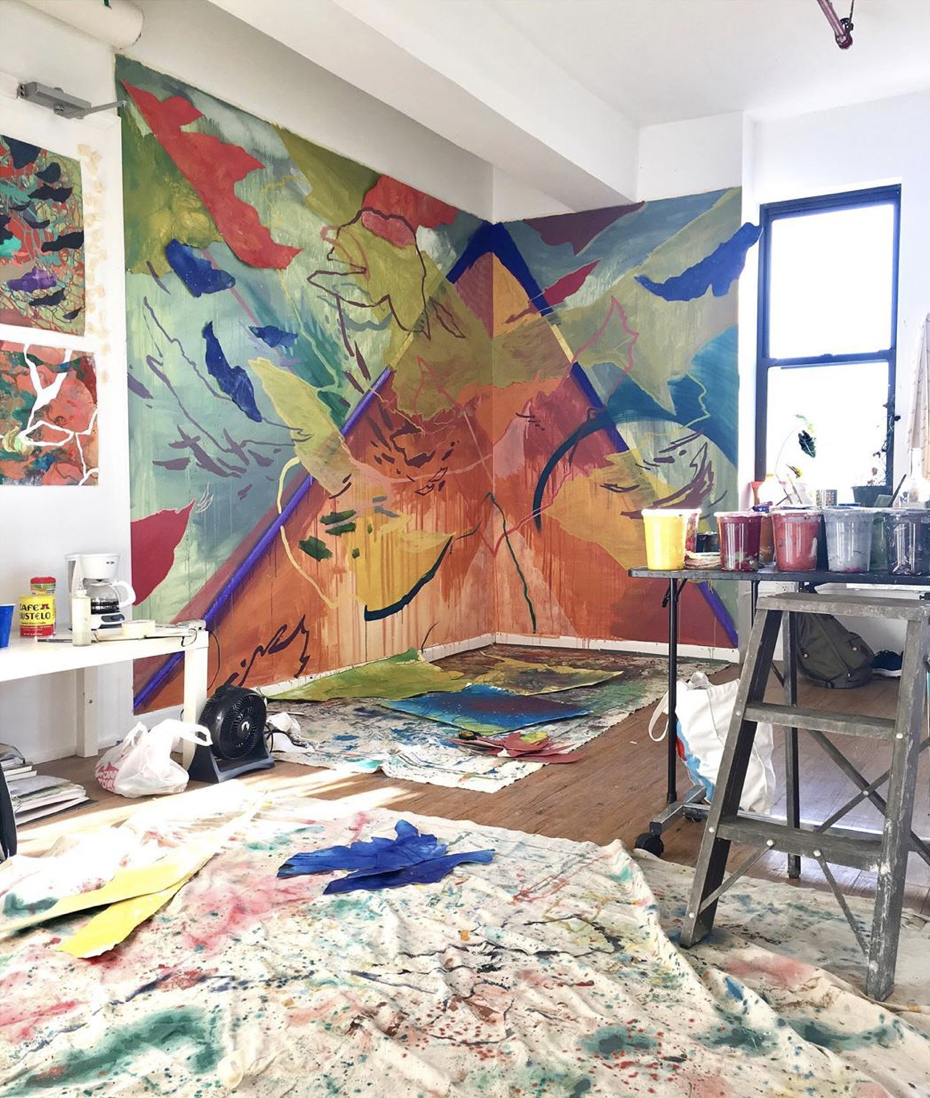Figuring out how you want to market and sell your art can be a daunting task in today’s volatile art world. For those of us who are just starting out and haven’t yet captured the attention of a brick-and-mortar gallery, selling online can be a great option. Naturally, there’s an overwhelming amount of ways to do this, but have no fear—we’ve broken them down into categories and chatted with several artists who use some of the more popular platforms about their experiences selling their art online.
1. The DIY Approach
Whether it’s simply adding a shopping feature to your main website or creating a whole separate site where collectors can buy your art, some artists prefer more freedom and individuality when making their work available for purchase online. If this sounds like you, there are plenty of options out there that allow you to take the reigns and design your platform with as much or as little help as you need.
Website: Big Cartel
Big Cartel is one such platform that allows visual artists and other creatives to do things their way. Setting up a shop is easy—pick a plan, pick a shop name, put in a few other details, and you’re in. They offer a Gold plan, which is free forever and a good way to see what Big Cartel is all about and make sure it’s the right fit you and your work. If you need your shop to do bit more for you, there are several levels of paid options to choose from. Big Cartel never takes a cut of sales: they only get paid if an artist wants or needs the features of a paid plan. There’s a small fee from the payment processors to handle the actual money part, but those fees are the same anywhere.
Artist using Big Cartel: Rebecca Chaperon, an artist from Vancouver, British Columbia, told us of her experience using the platform, “Big Cartel is the best for me and I usually recommend it to people who really want to sell online and have a nice design to their shop—one that is shopper friendly and customizable. I have found that the cost is so reasonable and I like to pay per month and I can upgrade or downgrade with their plans depending on how many items I have in my shop. The back end of keeping track of everything and marking when orders have shipped is simple and elegant. I sell quite a few originals online these days; I think people trust shopping online a lot more now. They don’t seem to mind not seeing a painting in person before they spend thousands on it. In my mind that makes it more important than ever to offer a great online shopping experience and that means finding the right platform that looks and functions the way that you want it to.”
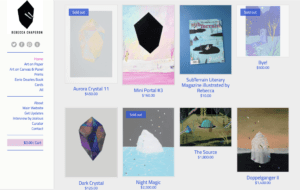
Website: Shopify
Unlike Big Cartel, this e-commerce platform is not only geared towards artists but anyone who wants to set up an online store. Much like Squarespace and other website-building companies, Shopify is a good option for those who need to build their sites from the ground up. Additionally, you can use Shopify to add buy buttons to items and a shopping cart feature to your website if you have one already. This can be a bit of a daunting option if you don’t know much about software and coding, but Shopify has plenty of resources available—you can even hire one of their experts if you need extra help. Since you pay by the month, it’s probably best for artists who already have an established audience and customer base.
Artist using Shopify: Painter Raven Roxanne from Charleston, South Carolina gave us her take on the platform: “Shopify is incredibly user-friendly and provides unique options and apps to small business owners to tailor the viewer’s experience. I also have the benefit of having a software developer and a coding husband who walked me through the functions of the platform and made unique changes to the code to make my site that much more ‘me’. This would be a con for those who do not have basic knowledge of coding or a resource like I have. I would also say that a con is the self-maintenance required for updating product details and inventory, but honestly, it’s not a terrible inconvenience and rather a matter of personal preference. The pros outweigh the cons!”
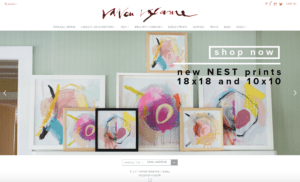
2. The Marketplace Approach
If you aren’t so web-savvy and don’t mind a predesigned shop format, you might consider using an online marketplace to sell your art. Another reason to use this approach to e-commerce is that in a sense, there is already a built-in customer base—people who regularly shop on these sites may come across your art by chance and want to buy it. Unfortunately, neither of the options we’ve chosen to feature here are completely free to use, but you may feel that the benefits are worth coughing up a little money.
Website: Society6
Anyone can join Society6. They have an open admissions policy: the only requirements are a Paypal account and a $1 verification fee. Artists make 10% of the sales of all products, except for prints, framed prints, and canvas prints, which they get to set the price and profit for, allowing them to price their work competitively and make the maximum profit for those items. For the rest of the products Society6 keeps the base cost, which is that other 90%, and it’s distributed between Society6 and the vendors, who print on demand. This covers the cost of materials and their service. All artists have to do is post their artwork online to make it immediately available for sale as a paper or canvas print or a plethora of other products, from phone cases and coffee mugs to clothing and even bedding. When the artist makes a sale, Society6 produces, packages and ships the product.
Artist using Society6: New York-based illustrator Amber Vittoria says of using the platform, “My Society6 shop is for all of my prints; their printing quality, paper quality, fulfillment turnaround and customer service are lovely. It is an excellent way to share art with others globally. S6 also does a wonderful job promoting their artists. One opportunity they are looking into is providing artists analytics on the sales of their pieces, which is incredibly exciting.”
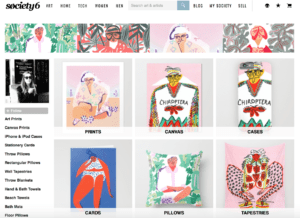
When it comes to selling art and other handmade products online, often the first company that comes to most people’s minds is Etsy. Joining and starting a shop on Etsy is free, and the pre-designed shop format is clean and simple. It’s easy to communicate with customers as well as with the Etsy support team if you need help. There are several low fees you have to pay to keep your shop running: a listing fee, a transaction fee, and a payment processing fee. It costs $0.20 to publish a listing to the marketplace. A listing lasts for four months or until the item is sold. Once an item sells, there is a 3.5% transaction fee on the sale price (not including shipping costs, as the seller is responsible for packing and shipping sold items). If you accept payments through Etsy’s Direct Checkout payment system, they also collect a 3% + $0.25 payment processing fee when an item is sold.
Artist using Etsy: Canadian artist Jessica Lucas said of selling prints of her work through her Etsy shop, “Selling prints on Etsy is a great way to get exposure and reach a different audience that might not have otherwise come across your work. When someone contacts me about my work for whatever reason, it’s often because they’ve seen it on Etsy. I’ve sold originals through Etsy without listing them because people figure that if there’s a print, there’s an original that might be for sale also. You can also see which of your pieces are the most popular if you care about that sort of thing. It’s a pretty saturated market, so it can be difficult to sell a lot of prints if you’re not willing to list at a low price. Living in Canada, shipping can be a challenge especially to the US where I find a lot of people are used to faster shipping at a lower price than I’m able to offer. It’s also difficult to figure out how to generate the most traffic to your store. It can help to have a large inventory of different items for sale, but that sometimes comes at the expense of your work.”

3. The Curated Approach
Many of the newcomers on the web-based art market frontier are curated platforms geared towards giving collectors an experience similar to buying from a brick-and-mortar gallery. For this reason, to sell on many of these sites, artists have to go through a selection process. There are various levels of exclusivity in this category—for some platforms, the selection process seems to be more of a formality, as artists are seldom turned away, whereas other sites are so selective that they don’t even have an open application process. Of course, one of the benefits of selling on this type of platform is that you may get noticed by some higher-profile collectors than those who tend to shop on the aforementioned marketplaces and DIY platforms. Recent additions to this category not profiled in this article include PotatoMike, Infinite Industries and TAPPAN Collective.
Website: Saatchi Art
This site is on the lowest end of the exclusivity scale—while they do feature weekly curated collections and select artists to feature in their newsletters and editorial content, anyone can create a profile on this platform to sell their art. Saatchi Art takes a 35% commission of each sale, and they handle shipping of artworks from the artist’s studio to the collector’s home and deal with customs if necessary. The number of artist profiles on this site is quite overwhelming, but Saatchi Art offers art advisory services for collectors who need help narrowing down their options.
Artist using Saatchi Art: UK artist Elliot Minor gave us his take on using Saatchi Art: “For me, Saatchi Art has been a useful platform to sell work and it’s definitely a great starting point for artists. If you don’t have a personal website or any particular artistic presence online, i.e. Instagram, Facebook, etc. it can be very hard to get your artwork seen further afield, so setting up an account on Saatchi Art, which takes no time at all, is a sensible first step and something which you can build from as your practice develops. Something to aim for while using Saatchi Art is to get selected for one of the features they organize; the top would be the ‘Invest in Art’ series and others include ‘One to Watch’ and ‘Inside the Studio.’ There is also a catalog too which is mailed out to the masses. To be chosen to take part in one of these will guarantee you some interest and sales as it simply places you in the forefront and therefore more people see your work. But the longevity isn’t there; after a couple of weeks there may well be another artist to take your place. So it has the potential to give artists new exposure; however, considering Saatchi Art is a worldwide platform with countless artists onboard it can be tricky to get noticed. All sorts of artists and creatives are on it, and some really aren’t that great either but I think being consistent, dedicated to the cause and regularly updating your work and information is important to let potential buyers and collectors know you’re still in the game.”

Website: Artspace
This platform, on the other hand, is on the higher end of the exclusivity spectrum. In fact, Artspace only accept work from artists who are represented by their gallery and institutional partners. They also sell a limited selection of home goods and fashion accessories. The site is intuitively curated, which makes for an easy shopping experience, and since they are so selective in what they sell and even who they partner with, they attract a bevy of blue-chip galleries and established collectors.
Artist using Artspace: New York-based illustrator and designer Julie Houts told us of using this platform, “I haven’t been selling with Artspace for very long, but I’ve had a good experience with them so far. They’ve been really easy to work with, and it’s been great to be able to reach so many people that I wouldn’t be able to reach just through promoting my prints through my Instagram. They’ve done a few things like send out an email blast calling out how affordable my prints are with a Q&A attached, and I saw a huge spike in sales through Artspace and through my own website after that. Speaking more broadly in terms of selling work online, I didn’t realize how much of a time commitment it was going to be to keep up with sales. I have enlisted a very patient and organized friend/angel who helps me manage the back end of the website and order fulfillment. I would really be struggling to manage all of it on my own if not for her!”
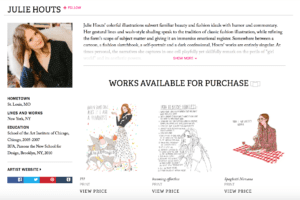
Illustration// Katita Miller



